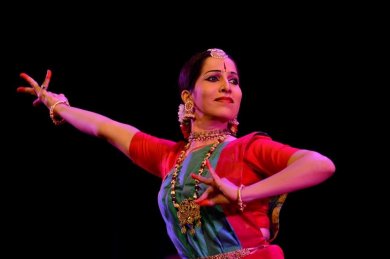
|   |

|   |
Nritya Margam - Radhika Shetty e-mail: radhikarecitals@gmail.com March 19, 2017  Nritya Margam, a traditional Bharatanatyam margam presented by
Vidyashree Radhakrishna on 12th March 2017 in Mangaluru was an evening
of soulful music and beautiful dance coming together. She commenced the
evening’s recital with Swaranjali in Ragamalika and adi tala,
beautifully composed by the performing vocalist, Srikanth
Gopalakrishnan. The choreography was fresh and the different elements
from Pushpanjali, Alarippu and Jathiswaram from the Bharatanatyam
repertoire were well blended into this opening composition that set the
mood for the evening. This ended with a sloka on Ganesha. Nritya Margam, a traditional Bharatanatyam margam presented by
Vidyashree Radhakrishna on 12th March 2017 in Mangaluru was an evening
of soulful music and beautiful dance coming together. She commenced the
evening’s recital with Swaranjali in Ragamalika and adi tala,
beautifully composed by the performing vocalist, Srikanth
Gopalakrishnan. The choreography was fresh and the different elements
from Pushpanjali, Alarippu and Jathiswaram from the Bharatanatyam
repertoire were well blended into this opening composition that set the
mood for the evening. This ended with a sloka on Ganesha. The high point of Nritya Margam, a beautiful culmination of the artistes on stage, was the Charukesi varnam, “Innum En Manam” composed by the violin maestro Lalgudi G. Jayaraman that was soulfully rendered by the vocalist and very aptly choreographed and presented by the dancer. “The playful child, Krishna who won the hearts of people to the mischievous one who stole the hearts of the Gopikas, didn’t come to me all these years and I am still yearning for you,” was part of the sanchari bhava for the pallavi. The trikala jathi was differently choreographed, where the muktaayam had the blending of the three words from the varnam pallavi. Vidyashree continued the evening’s performance with four abhinaya compositions that brought out her prowess in abhinaya with the compositions set in different moods. The Tamil padam “Yarukkagilum bhayama” in Begada, mishra chapu, a composition of Subbarama Iyer was presented with the right attitude that the nayika demanded. She continued with lament to the birds, “Innuir sevalum neerum koovikkondingu” where the nayika depends on three birds to convey her pangs of separation from her lord, Vishnu. She asks the cuckoo, “Why don’t you coo my love to him.” The parrot’s red beak reminds her of the lips of the lord, while the Garuda is his vehicle. The interaction with the birds was visually appealing. The composition in Ragamalika, adi tala was choreographed by Rama Vaidyanathan, Vidyashree’s current guru. The next two Kannada compositions choreographed by Vidyashree showcased her subtle abhinaya. “Houdene Uma,” a composition of Dr. G.S. Shivarudrappa in Shudhha Dhanyasi is a dialogue between a mother and Uma where the mother asks, “Are the people speaking the truth? Is Shiva roaming around everywhere with the ash smeared body? Are you planning to smear that ash on your golden coloured body?... Next time he is at our doorstep, I will not tell him your whereabouts.” This composition was an interesting interpretation of a Kannada poem. The next one saw Vidyashree show the audience the little Krishna on stage. A famous Purandaradasa composition, “Gummana kareyadire” was rendered beautifully. The mischievous Krishna allows the calves into the cowshed to drink all the milk. Seeing this, mother Yashoda tells him that she is going to punish him by calling the demon. So, little Krishna pleads and begs her not to call the demon, he would do as she said. This composition was set to Thilang raga, adi tala. The evening’s final presentation was yet another Lalgudi G. Jayaraman composition, Thillana in raga Desh, adi tala, with a few verses from Vande Mataram. It would not be wrong to say that Nritya Margam would not have been such a resounding success without the invaluable contributions from the musical ensemble: Nattuvangam by Aparna Kishor (Manipal), vocal by Srikanth Gopalakrishnan (Chennai), mridangam by Nagai Shriram (Chennai), violin by Subbaraman (Palakkad), and flute by Nithish Ammannaya (Udupi). Vidyashree is all set to go places with her solo performances and is poised to enthral audiences. Bharatanatyam dancer Radhika Shetty is director of Nrityaangan, Mangaluru. |